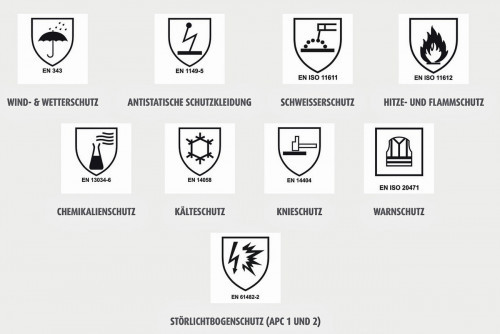In electroplating shops, safety shoes and safety goggles are mandatory and acid-proof clothing is also a must. In addition, there are some practical features to consider that make life easier for everyone involved when it comes to work and protective clothing.
The earliest protective clothing was against the cold. Skins and leather padded with straw shielded Stone Age people from the harsh conditions. Soon people also had to be on their guard against their peers, metal armor kept out the sword blows of their enemies. But clothing not only performed functional tasks, it was also used to adorn oneself or to set oneself apart from others with certain fabrics and colors. Early types of work clothing were created.
 Binding pictograms for different types of protectionInfact, a distinction is still made today between work clothing and protective clothing. Work clothing is, for example, the blouse with the company logo worn by employees at the supermarket checkout. Or the livery of the hotel bellboy, the uniform clothing of the train attendant or even the jerseys of team athletes.
Binding pictograms for different types of protectionInfact, a distinction is still made today between work clothing and protective clothing. Work clothing is, for example, the blouse with the company logo worn by employees at the supermarket checkout. Or the livery of the hotel bellboy, the uniform clothing of the train attendant or even the jerseys of team athletes.
Protective clothing includes everything that protects the wearer from dangerous influences. This includes protective goggles, clothing against extreme cold and heat, high-visibility clothing, lead vests against radiation and much more.
While certain protective clothing is mandatory in some areas of industry, trade and crafts, the wearing of work clothing is not regulated by law. An employer who wants his employees to wear uniform clothing, for example, must stipulate this in the employment contract. He cannot force an employee to do so. If there is a company-internal obligation to wear company clothing, the employer must provide this and pay for its maintenance. However, if the employee has special requests, e.g. brown shoes instead of the black ones offered, they must pay for this themselves.
For the employer, this means the high cost of company clothing on the one hand and the additional risk of employees not feeling comfortable in their clothes on the other. Anyone who has previously managed without uniform clothing should consider the advantages and disadvantages carefully. And then approach the introduction carefully and in a structured manner. The following tips, for example, could be helpful:
1 Involve employees
Workwear is subject to a co-determination process by the workforce, especially in larger companies. However, it is always advisable to involve employees at an early stage. Workwear can be an emotional issue with differing opinions. An employee representative body, for example, which is determined by colleagues, can be involved and make suggestions or communicate further.
If they are involved, this not only increases acceptance of the clothing in the team, but also the sense of belonging to the company. However, if you give employees a free choice and only provide them with a budget, you should consider whether this also ensures the best possible appearance for the company. A team should always form a visual unit. If employees are given a free choice, there is always a risk that completely different clothing will be purchased according to personal taste rather than requirements and a harmonious team appearance.
2 Carry out a wear test
Clothing should be tested in everyday life before it is purchased. It is therefore advisable to use two favorite collections for a few employees in a test phase. These employees can then evaluate the workwear by answering a few questions. Is the clothing hard-wearing and comfortable to wear for all activities even after a week? Does it meet the requirements for the area of use? Does it retain its shape even after several washes? This can be easily answered with a jointly created questionnaire. The results are then evaluated and compared with regard to long-term use.
3 Pay attention to the material composition
Whether workwear is appealing and comfortable can also be subject to individual subjective criteria. It is therefore advisable to always look at the fabric composition. This provides information on whether the clothing is robust, sustainable and also comfortable to wear. In principle, a high cotton content is an indicator of a good wearing comfort. If the fabric has a higher weight, this is also an indication of a more robust material.
If you don't want to compromise on comfort, you can always recognize comfortable clothing by its stretch inserts, which ensure plenty of freedom of movement and comfortable working. This allows kneeling or squatting and flexible movements without the clothing pinching or restricting. Those responsible should therefore seek detailed advice on the material. Often, people only look at the appearance and choose clothing that does not fit the requirements of everyday life.
4 Work clothing must fit
Optimal wearing comfort also includes the fit. It is therefore not only important to choose the right size, but also the overall fit. Every garment is different. If the size does not fit an employee, the procurement process should allow sizes to be exchanged. The same applies to leg or arm length. If the workwear fits properly, it not only looks more professional, but also increases employee satisfaction and makes work easier.
5 Little time required
Ideally, employees should have to worry as little as possible about their own workwear. Nowadays, the majority even expect companies to take care of washing their clothes. Companies that want to retain their employees also show their appreciation by taking care of the laundry. At the same time, he or she ensures that employees always have clean clothes.
 Various protective equipment such as safety shoes, helmets, goggles, etc. (Photo: NHBNBN)If the employer insists on a uniform appearance, they want to promote a corporate identity. This image plays a decisive role, especially in customer contact. If this uniform image is disturbed externally, it is considered unprofessional.
Various protective equipment such as safety shoes, helmets, goggles, etc. (Photo: NHBNBN)If the employer insists on a uniform appearance, they want to promote a corporate identity. This image plays a decisive role, especially in customer contact. If this uniform image is disturbed externally, it is considered unprofessional.
In this case, the dress code should be laid down in advance in a company agreement or in the employment contract. The alternative to the sometimes very strict dress code is the dress code. Here, only certain requirements regarding appearance at the workplace are agreed.
Even if all legal agreements have been made and are binding, there is one thing the employer may not do: require the employee to wear company clothing when traveling to and from work.
However, there are also workplaces where it is a legal requirement to wear certain protective clothing. In this case, neither the employer nor the employee has any discretion. On the contrary, even the technical design of the protective clothing is prescribed by law.
Different types of hazards require different designs of protective clothing, which are subject to standardization.
EN 342
Products certified to EN 342 can be worn in cold areas where the combination of an air temperature of -5 °C and below, moisture and wind increases the need for insulating clothing.
EN 343
This pictogram provides information about the degree of protection. The numbers next to the pictogram mean
x: Resistance of the outer jacket to water penetration from the outside (waterproofness)
3 = Highest level of protection
1 = Lowest degree of protection
y: Resistance to moisture (breathability). The value indicates how well water vapor produced by sweating is wicked away to the outside by the outer material
3 = Very good drainage
1 = Low drainage
EN ISO 20471
The EN ISO 20471 standard is divided into 3 classes. The class designation describes how well the product can make the wearer visible. The larger the area with fluorescent material and retroreflective material, the higher the classification. The fluorescent material offers better visibility in daylight and at dusk, while the retroreflective material becomes visible when the light of a vehicle or a work light hits the wearer in the dark.
GO/RT 3279
The "Railway Group Standard" sets minimum requirements for the visibility of high visibility clothing (fluorescent orange color) in rail traffic.
EN ISO 11612
Protective clothing in accordance with EN ISO 11612 protects against brief contact with heat and flames. The standard is divided into different categories. The code letter indicates which requirements the garment fulfills. Each category is also divided into different codes depending on the protection class offered.
(A1) Limited flame spread
(A2) Edge flame spread
(B) Convective heat, code 1-3, where 3 is the best value
(C) Radiant heat, code 1-4, where 4 is the best value
(D) Molten aluminum splash, code 1-3, where 3 is the best value
(E) Molten iron splash, code 1-3, where 3 is the best value
(F) Contact heat, performance level 1-3 (3 = highest)
EN ISO 11611
Protective clothing according to EN ISO 11611 protects against welding/spattering of molten metal and sparks as well as heat in the form of convective or radiant heat.
Cl. 1 Protects during less hazardous welding techniques and in situations where spatter and radiant heat occur to a limited extent. Metal spatter 15 drops. Radiant heat 7 seconds
(A1) Limited flame spread
Cl. 2 Protects in more dangerous welding techniques and in situations where more spatter and radiant heat is generated. Metal spatter 25 drops. Radiant heat 16 seconds
(A2) Limited flame spread, edge flaming
EN 1149-5
Protective clothing with antistatic properties. The clothing protects against sudden discharges of electrostatic energy where there is a risk of static sparks igniting flammable or explosive atmospheres.
The wearer must be correctly earthed, e.g. by wearing suitable footwear. The clothing must be in contact with the skin.
FprEN 61482-2
Protective clothing in accordance with EN 61482-1-2 protects against the thermal hazards of an electric arc. The standard states that the clothing protects against electric arcs and is divided into 2 classes.
Class 1 Protection against electric arcs 4kA
Cl. 2 Protection against electric arcs 7kA
EN 13034-6
Protective clothing in accordance with EN 13034-6 protects against splashes of liquid chemicals. It is intended for use at low risk and in situations where a complete protective barrier against liquids is not required, i.e. when the wearer is able to take timely action if his clothing is contaminated. Low risk may involve the wearer being exposed to small amounts of spray or accidental splashes.
The product has been tested for the following chemicals:
- Sulphuric acid, 30% solution
- caustic soda, 10% solution
- Dimethylbenzene
- xylene
- Butanol-1
- Phosphoric acid, 10% solution
FOR INFO
Some contacts
Please note: The list of professional suppliers in this field is almost endless. We are only naming a handful here, without any claim to completeness.


